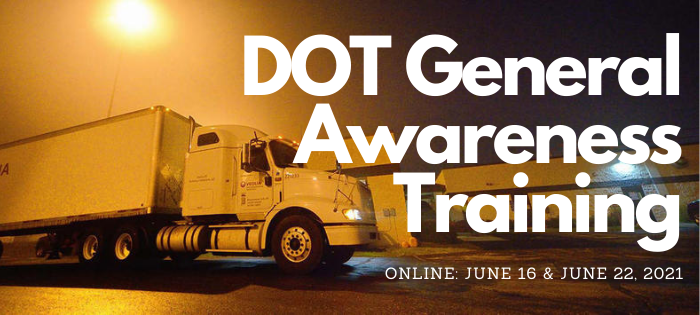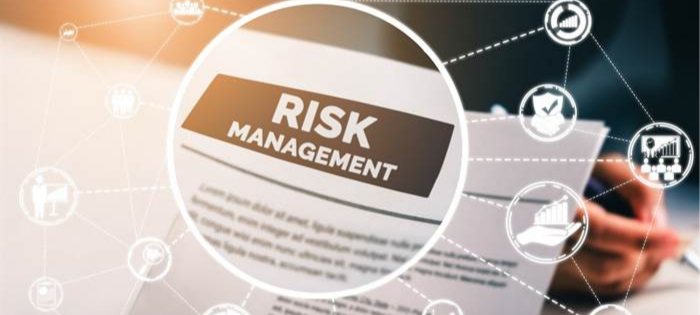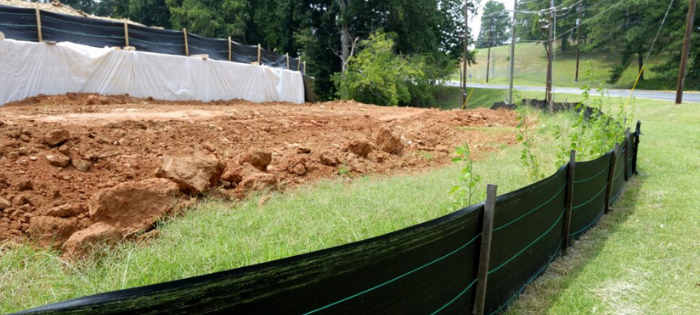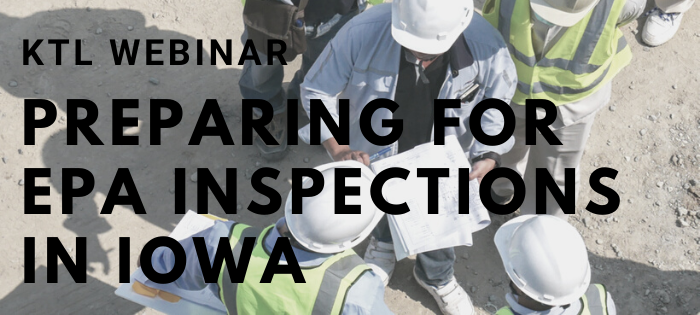
DOT General Awareness Training: June 16 & 22, 2021
Department of Transportation (DOT) code (49CFR172.702) requires that any employee involved in the transportation (shipping or receiving) of hazardous materials must be trained and tested in general awareness, safety, site-specific job functions, and transportation security.
8-hour DOT General Awareness Training (ONLINE)
June 16 (part A) & June 22 (part B), 2021
8:30 am – 12:30 pm CT
REGISTER NOW!
KTL’s 8-hour DOT General Awareness Training (held as two 4-hour sessions online on June 16 and June 22) is applicable for all companies that ship hazardous materials, ship hazardous waste, or prepare shipments of hazardous materials/waste for transport. It teaches all topics required for DOT general awareness training and general security training and will meet the requirements for triennial training certification.
Topics covered include:
- Code training requirements
- Shipping papers
- Hazardous materials table
- Incident reporting
- Hazard classes
- Common violations and confusing specifics
- Marking, labeling, and placarding
Cost: $198/participant. This online DOT training is held as two 4-hour sessions: June 16 (Part A) and June 22 (Part B) from 9 am – 1 pm. To receive CERTIFICATION, participants MUST complete Part A and Part B and pass both post-tests with 80%.
Training Details
- Training sessions will be held via Zoom. Link will be provided prior to class.
- Training is scheduled to begin at 8:30 am and end at 12:30 pm CT (or until material is complete).
- Participants will receive a training manual, pre-/post-competency test, exercises, and a certificate of completion, provided they receive an 80% or above on the test.
- Registration closes 72 hours prior to the scheduled training. KTL has the authority to cancel training with 72-hours notice if class size is not large enough.

EHS Compliance: Top Issues
Companies committed to environmental, health, and safety (EHS) compliance face a complicated array of federal, state, and local regulations that may vary by industry sector, facility size, setting, and location. Technical EHS compliance has undergone significant changes over the last several of years—and more is likely to come in the foreseeable future. The evolving EHS landscape presents some significant challenges that companies must address to remain in compliance.
Pandemic
The COVID-19 pandemic has certainly impacted EHS, as it has other operations. There are probably few organizations that have not implemented operational changes on some level to respond to the pandemic—whether that has involved more remote working situations for staff, increased or decreased production, or updated travel and health and safety guidelines.
Changes such as these have had a cascading impact on the way organizations and EHS operations work. With more staff working from various and often remote locations, Cloud-based access EHS and facility documents, records, and shared applications has become essential. Employees need access to everything regardless of location. Along the same line, virtual monitoring methods have also become a necessity. With new guidelines for travel and who may be allowed in a facility, in-person monitoring, assessing, and auditing to meet EHS compliance requirements may not be possible for some facilities.
After over a year of adjusting to a new way of operating through the pandemic, resuming “normal” operations can present additional challenges. Workplace culture has undoubtedly changed. Defining what the culture is as individuals may (or may not) return to the work environmental will requirement management of change and, likely, training. It is important for organizations to address workplace changes and expectations and to evaluate new ways of doing business.
Staffing
EHS department understaffing has long been reported as an issue. In a 2016 study done by Triumvirate, 72% of companies reported EHS understaffing. Many organizations do not have dedicated EHS resources, and many EHS departments often consist of one individual who fulfills multiple roles. Internal resource growth as operations resume is questionable, as EHS expertise can be expensive. This presents an even bigger issue with many experienced workers—often those with the facility EHS background—electing not to return to the workplace full time. This is an area where EHS compliance efficiency and tracking tools are becoming essential to allow companies to do more with fewer resources.
Regulatory Uncertainty
Not surprisingly, EHS regulations—climate change, air, waste, water—are undergoing seismic shifts with the new Administration taking office. Some of these notable changes include the following:
- Environmental Protection Agency’s (EPA’s) new Waters of the U.S. (WOTUS) Rule
- Major Lautenberg Law Amendments to the Toxic Substances Control Act (TSCA)
- Chemical Safety Board’s (CSB’s) new Chemical Release Reporting Rule
- Latest Clean Air Act (CAA) requirements for facilities
On top of this, the differences between state and federal regulations are growing in many states. Organizations need to understand what requirements are applicable and what must be done to maintain compliance at all levels.
Enforcement
From 2017-2020, the U.S. experienced the lowest number of Occupational Safety and Health Administration (OSHA) inspections in over 10 years—including fewer complex investigations. In this same period, the Agency also has had the fewest OSHA inspectors conducting inspections in 40 years.
Not surprisingly, COVID has stalled many enforcement activities and court cases. However, despite COVID, EPA issued approximately $3 million in fines in Q3 of 2020:
- > $1.5 million Resource Conservation and Recovery Act (RCRA)
- > $1 million in Clean Air Act (CAA)
- > $0.5 million in Clean Water Act (CWA)
With the new Administration and resumed business activities, the frequency of comprehensive multimedia environmental inspections appears to be increasing. EHS regulatory enforcement is regaining momentum and likely will continue over the next few years.
Facing the Challenges
Achieving and maintaining EHS compliance requires great management and expertise to ensure all aspects of a company’s technical compliance have been identified and are being actively managed. A management system can provide the organizing framework to enable organizations to achieve and sustain their operational and business objectives through a process of continuous improvement. Information technology (IT) can further help to carry out daily tasks, connect staff, manage operations—and play a vital role in managing compliance requirements.
A compliance information management system brings IT and management systems together to coordinate, organize, control, analyze, and visualize information in such a way that helps organizations remain in compliance and operate efficiently. A system like this will help provide operational flexibility, generate business improvement, and prepare organizations to address these and other EHS compliance challenges that will continue to surface.

Comments: No Comments
RMP and Section 114 Requests: Are You Prepared?
As a facility environmental or plant manager, one of the most daunting letters you can receive is a Section 114 request from the U.S. Environmental Protection Agency (EPA). Under Section 114 of the Clean Air Act (CAA), EPA is authorized to require facilities to provide information about their operations. EPA can then use that information to develop new emissions standards or, as the case may be, to determine whether a facility is in violation of a rule or standard.
Section 114 Requests
Under the new administration, EPA sent out a Section 114 request earlier in 2021. This request asks facilities questions pertaining to compliance with Section 112(r) of the CAA, which requires facilities that store or use enough of a hazardous chemical to develop and implement a Risk Management Plan (RMP), as codified in 40 CFR 68.
While EPA normally asks for Section 114 responses within 30 days, they are providing leniency because of the COVID-19 pandemic. Despite the additional time, many facilities receiving this letter may not have the background to understand the requirements of the RMP program, whether their facility is in compliance, and how to respond to EPA’s request.
RMP Program
The RMP program was developed in the 1990s. RMP regulates approximately 12,500 facilities, including agricultural supply distributors, waste/wastewater treatment facilities, chemical manufacturers and distributors, food and beverage manufacturers, chemical warehouses, oil refineries, and other chemical facilities.
The goal of the RMP program is to prevent accidental releases of toxic substances that can cause serious harm to the public. To do this, the program requires subject facilities to develop and implement an RMP for their specific operations. According to EPA, “The RMP rule requires facilities that use extremely hazardous substances to develop a Risk Management Plan which:
- identifies the potential effects of a chemical accident,
- identifies steps the facility is taking to prevent an accident, and
- spells out emergency response procedures should an accident occur.”
Modeling Analysis
The RMP must include an air dispersion modeling analysis that addresses air pollution impacts from both a worst-case release of a toxic substance (e.g., a storage tank that ruptures and releases all its contents) and an alternative/more realistic release of a toxic substance (e.g., a loading hose that gets unhinged). This modeling establishes how far from the facility potential harmful impacts can occur and then identifies public receptors within that area—locations where the public would be at risk should an accident occur. These public receptors include schools, residences, parks, hospitals, etc.
In most cases, the required modeling is known as “dense gas” modeling, because typically the toxic substances covered by this rule behave as dense gas when they hit the atmosphere. For example, ammonia is liquefied under pressure in many refrigeration systems. If that ammonia is suddenly released to the atmosphere, it forms a mixture of vapor and very fine liquid droplets, and those droplets quickly cool the nearby air such that a cold mixture of air and ammonia vapor is formed. This mixture is denser than air and thus needs to be modeled appropriately. The dispersion model most often used for industries, AERMOD, is not the right model in this case.
Next Steps
For facilities who have received a Section 114 request and/or who are impacted by the RMP, it is important to:
- Understand the hazards posed by chemicals at the facility.
- Assess the impacts of a potential release.
- Design and maintain a safe facility to prevent accidental releases.
- Coordinate with local emergency responders.
- Minimize the consequences of accidental releases that do occur.
KTL has experience working with a broad cross-section of industries impacted by RMP, particularly chemical companies. We have created RMP and General Duty Clause audit protocols, conducted audits and investigation/improvement programs following significant release events. In addition, our team provides Tier II and TRI reporting, writes plans for OSHA and Emergency Response, routinely works with Local Emergency Planning Commissions (LEPCs) to coordinate emergency response efforts and exercises to keep communities informed and safe, and has partnered with Blue Sky Modeling to provide the required air dispersion modeling analysis.
About Blue Sky Modeling LLC
Blue Sky Modeling, LLC (BSM) is a KTL partner specializing in air quality modeling. BSM primarily models emissions of air pollutants using traditional air dispersion models (i.e., AERMOD and CALPUFF) in support of air quality permitting efforts. In addition to traditional air dispersion modeling, BSM also performs both accidental release and noise modeling; negotiates modeling strategies with air quality regulators; teaches air dispersion modeling courses; and provides expert testimony on modeling issues. BSM has modeled every type of source imaginable, including, but not limited to, oil and gas, power generation, smelting, cement, and chemical.

Webinar: Challenges of EHS Compliance in the U.S.
Current Challenges of Technical Compliance in the U.S.:
Focus on Occupational Health & Safety and Environment
May 17, 2021 | 4 pm – 5 pm CT
Technical compliance regarding EHS has seen tremendous changes over the last couple of years and is likely to change even more in the foreseeable future. EHS regulatory enforcement will undoubtedly regain momentum in the next few years. Achieving and maintaining EHS compliance requires great management and expertise to ensure all aspects of a company’s technical compliance have been identified and are being actively managed.
KTL’s Sarah Burton will be joining Martin Mantz Compliance Solutions, our German alliance partner, to discuss the challenges of technical EHS compliance and to provide an up-to-date understanding of technical compliance in the U.S. today.

Demonstrating Compliance in a Socially Distanced World
Don’t miss this free American Bar Association event on April 22, 2021 — Demonstrating Compliance in a Socially Distanced World: Virtual Auditing.
In the time of COVID-19, virtual auditing has become increasingly necessary and valuable to organizations as they seek to achieve environmental compliance while facing worldwide travel restrictions and remote work policies that have disrupted routine in-person audits. With this shift, comes the need for both regulated entities and regulators to develop new approaches and procedures to ensure the effectiveness of audits conducted remotely. Practitioners, including auditors and legal counsel, must consider new dynamics related to security, data protection, and audit integrity-on top of the usual audit considerations. This session will highlight some of these new challenges and provide real-world solutions to aid attendees form new practice skills to apply in the (virtual) field.
Panelists–including KTL’s Sarah Burton–will explore the new world of remote auditing, focusing on real-world solutions to the challenges that virtual auditing presents.

Comments: No Comments
Q&A on CDR
Under the Toxic Substances Control Act (TSCA), certain manufacturers (including importers) must provide the U.S. Environmental Protection Agency (EPA) with information on the production and use of chemicals in commerce. This is done through a Chemical Data Reporting (CDR) report. CDR is required for all chemical substances listed on the TSCA inventory, with some exceptions, as discussed below.
EPA uses CDR to collect basic exposure-related information, including information on the types, quantities, and uses of chemical substances produced domestically and imported into the United States. This data is important, because it allows the Agency to assess potential human health and environmental impacts of chemicals and to share up-to-date information with the general public on chemical risks.
Manufacturers and importers who work with chemicals must understand TSCA and CDR, how the rules apply, and what is required to ensure compliance.
What Is CDR?
The CDR rule was originally issued under TSCA in the 1980s as the Inventory Update Reporting (IUR) rule. In 2011, EPA changed the name to CDR to recognize the changes in reporting requirements over the past several decades.
Today, CDR remains a means to collect information on basic chemical exposure, including types, quantities, and uses of chemicals produced domestically and imported to the United States. According to this rule, manufacturers and importers must report on production and use of chemicals in commerce if specified thresholds are met.
What Is TSCA?
TSCA was published in 1976 to provide EPA with the authority to require reporting, recordkeeping and testing requirements, and restrictions related to chemical substances. In 2016, President Obama signed the Frank R. Lautenberg Chemical Safety for the 21st Century Act, which modernized and updated TSCA to include the following:
- Mandatory requirement and clear deadlines for EPA to evaluate existing chemicals
- Risk-based chemical assessments
- Increased public transparency for chemical information
- Consistent source of funding for EPA to carry out responsibilities
The CDR rule remains a key component of TSCA, as revised under the Lautenberg Chemical Safety Act.
Who Must Report under the CDR Rule?
The CDR rule applies to manufacturers and importers of chemicals who meet specified production volume thresholds:
- In general, the threshold is 25,000 lbs. or more of a chemical substance at any single site during any calendar year since the last principal reporting year.
- With respect to chemicals that are subject to certain TSCA actions, a reduced threshold of 2,500 lbs. may apply.
Are Any Chemicals Exempt from Reporting?
Certain types, manner of manufacture/import, or use of chemicals are exempt from CDR reporting (i.e., polymers, microorganisms, naturally occurring chemical substances, water, and certain forms of natural gas when manufacture (including import) of those chemical substances meets other reporting requirements).
It is important for facilities to assess whether they have chemicals that fall into the following categories, as outlined by EPA, which are all exempt from CDR:
- Chemicals manufactured or imported for non-TSCA uses are not required to be reported (e.g., pesticides are exempt from reporting under CDR by TSCA). If a portion of a manufacturer’s or importer’s production is not subject to TSCA (e.g., if the use is regulated by the Food and Drug Administration (FDA)), that portion will not be reported to CDR. Note that manufacturers may report downstream non-TSCA uses for their chemical.
- Generally, water and naturally occurring substances are exempt from CDR requirements. Three other groups of chemicals (i.e., polymers, microorganisms, and certain forms of natural gas) are also generally exempt. However, it is important to note that a particular polymer, microorganism, or form of natural gas may not be exempt if the chemical becomes the subject of certain TSCA actions (e.g., an enforceable consent agreement).
- Chemicals that are non-isolated intermediates, imported as part of an article, impurities, or byproducts destined for certain commercial uses are exempt from reporting.
Are Any Manufacturers/Importers Exempt from Reporting?
EPA recently amended the definition of small manufacturer in 2020 in accordance with TSCA. This provides an exemption from reporting for manufacturers who meet the following criteria:
- Total sales during 2019 combined with those of the parent company (domestic or foreign) are less than $ 12 million; or
- Total sales during 2019 of the parent company (domestic or foreign) are less than $120 million and annual production volume of a qualifying chemical substance does not exceed 100,000 lbs. at any individual site. If the annual production volume of the chemical substance exceeds 100,000 lbs. at a site, the manufacturer is required to report for that particular site.
How Is the CDR Rule Different from Toxic Release Inventory (TRI) Rule?
CDR collects exposure-related information and requires manufacturers/importers to report industrial, commercial, and consumer use information for certain chemical substances on the TSCA inventory. TRI, on the other hand, is designed to track the management of certain toxic chemicals that might pose a threat to human health and the environment. Under TRI, regulated facilities must report on releases and waste management of specific chemical substances under the Emergency Planning and Community Right-to-Know Act (EPCRA).
How Often Must Data Be Reported?
Impacted manufacturers and importers must and submit information to the EPA every four (4) years. For chemical substances that trigger reporting, total annual production volume must be reported for each calendar year since the last principal reporting year. The 2020 submission reporting period was based on data for the calendar years 2016-2019. The next submission period will be 2024 for data collected from 2020-2023.
How Do Companies Submit CDR Data?
Companies subject to reporting must submit the required information using e-CDRweb, the CDR web-based reporting tool. To access this reporting tool, companies must register on EPA’s Central Data Exchange (CDX) system.
What Should I Do Now to Prepare?
The most recent submission period closed on January 29, 2021. To prepare your company for the 2024 submission:
- Keep records on production volume of imported and manufactured chemical substances.
- Follow EPA actions under TSCA to check if they have an impact on your reporting requirement.
- Make sure to submit your report within prescribed deadline; otherwise, you may be subject to EPA enforcement action.
- Visit the CDR website for program updates, announcements, and other guidance materials.

Comments: No Comments
SWPPP Best Practices
Spring is here…warmer temperatures, melted snow, anticipated rain, and, potentially, elevated flood warnings. Spring thaw is a critical time to evaluate potential runoff impacts from storm waters and to ensure compliance with regulatory requirements for storm water management.
Permit Requirements
According to the U.S. Environmental Protection Agency (EPA), “The National Pollutant Discharge Elimination System (NPDES) permit program addresses water pollution by regulating point sources that discharge pollutants into the waters of the United States.” NPDES permits are issued by states that have obtained EPA approval to issue permits or by EPA Regions in states without such approval.
Businesses with specific SIC/NAICS codes are required to have an NPDES permit or a No Exposure certification in place to help ensure protection of the nation’s surface waters. If a business is required to have an NPDES permit, they are also required to have a Storm Water Pollution Prevention Plan (SWPPP) for their site.
What Is a SWPPP?
A SWPPP is a site-specific, written document that is required to comply with a storm water general permit. The primary goal of the storm water permit program is to improve the quality of surface waters by reducing the number of pollutants potentially contained in the storm water runoff. The SWPPP describes:
- Potential sources of storm water pollution at the site
- Activities to control sedimentation and erosion
- Practices to reduce pollutants in storm water discharges from the site
- Procedures to comply with the terms of the general permit and Clean Water Act (CWA) requirements
SWPPPs are intended to be “living” documents that are updated to reflect changes at the site. With spring thaw and rains in the forecast, it is important to review the SWPPP and any Best Management Practice (BMP) strategies to ensure the site is effectively managing storm water and meeting permit and regulatory requirements.
SWPPP: Key Parts and Pieces
The SWPPP identifies potential sources of pollution that may reasonably be expected to affect the quality of storm water discharges associated with activity at the facility. The plan also describes the implementation of practices that are to be used to reduce those pollutants. The SWPPP, which should be prepared in accordance with good engineering practices, documents the following:
- Summarizes major activities conducted at the facility.
- Inventories exposed materials and summarizes storm water sampling requirements for the facility.
- Identifies potential source areas of storm water contamination and significant polluting materials.
- Identifies Best Management Practices (BMPs) for facility activities.
- Identifies impacts of BMPs.
- Identifies the individuals who will implement the SWPPP.
- Provides information on required storm water inspections.
- Discusses training requirements.
- Provides a means of recordkeeping for storm water-related documents at the facility.
- Provides a non-storm water discharge assessment.
- Summarizes storm water discharge regulatory applicability and implementation schedule.
- Fulfills the requirements of the General Permit issued to the facility.
SWPPP Development: Best Practices
EPA cites a number of common compliance problems associated with SWPPPs in its SWPPP guide. Based on KTL’s experience, the following best practices can help ensure successful development of the SWPPP and implementation of the overall storm water pollution program to avoid those pitfalls.
- Determine whether you need a SWPPP. Many facilities do not realize they need a SWPPP. Others may use a generic template to fulfill the need. To be effective, SWPPPs should be customized to address site-specific operations.
- Implement control measures. The SWPPP identifies control measures for managing storm water. It is vital that those control measures outlined in the SWPPP are the control measures that are actually being used at the site. As operations change and control measures change, the SWPPP must be updated.
- Keep a copy onsite. A copy of the SWPPP—hard copy or electronic—must be maintained onsite at all times in case of a regulatory inspection.
- Authorize the SWPPP. A responsible facility representative must sign and authorize the current version of the SWPPP.
- Identify and train your storm water pollution prevention team. The storm water pollution prevention team identified in the SWPPP must be current, familiar with the storm water program, and adequately trained on the program and their respective roles/responsibilities.
- Collect representative visual assessment samples. Visual storm water samples collected from pooled areas onsite are not representative, as these areas tend to concentrate pollutants.
- Cover dumpsters. This is a simple action that is often overlooked. Dumpsters from contract waste collection agencies must be appropriately sealed to prevent leaking oil or other contaminants. Check with your regulatory authority on what is required for outside dumpsters—even those for contractors.
- Control outdoor storage. Keep outdoor storage to a minimum. Store only items specified in the SWPPP in the designated storage areas.
- Maintain inspection and monitoring records. Facilities are required to maintain records of routine site inspections, visual assessments, monitoring results, and implementation of practices required in the permit.

Environment / Food Safety / Quality / Safety / Technology Enabled Business Solutions
Comments: No Comments
From Paper Management to Digital Management
Virtually every regulatory agency (e.g., EPA, OSHA, FDA, USDA) and voluntary certification standard (e.g., ISO, GFSI, organic) has compliance requirements that call for companies to fulfill several common compliance activities. KTL has outlined eight compliance functions that can be instrumental in improving a company’s capability to comply. One very important compliance function involves records and document management.
Records provide documentation of what has been done related to compliance—current inventories, plans, management systems, training, inspections, and monitoring required for a given compliance or certification program. Each program typically has recordkeeping, records maintenance, and retention requirements specified by type. Having a good records management system is essential for maintaining the vast number of documents required by regulations and standards, particularly since some, like OSHA have retention cycles for as long as 30 years.
Moving Away from Paper Recordkeeping
Organizing and maintaining the records can create challenges—where to store them, security levels, remote and local accessibility, etc. Supply chain requirements can further add to the cumbersome workload of collecting, reviewing, and sharing documents and information.
Companies have been keeping records and documents in binders and file cabinets for years. And while that system can work, many dynamic tools are available to alleviate some of these challenges and support organizational decision-making. A document management system can help create:
- Process and document standardization
- Central and secure storage, organization, and access to documents and records locally or remotely
- Improved document searchability and accessibility
- Enhanced workflows for approving and completing tasks involving documents
- Easy access to documents for audits and clear audit trail, particularly for remote audits
- Version control and history
- Reduced paperwork
- Higher quality data due to reduced human error
- Improved collaboration
- Improved security of sensitive documents
All of which lead to consistent, efficient, and reliable compliance performance.
Transitioning Your Records
Transitioning from a paper-based recordkeeping system to an electronic document management system can seem overwhelming, particularly given the sheer volume of documents some organizations have. However, following a step-by-step approach—and considering the desired end product from the start—can help ensure that organizations end up with a system that will function well within the business context and provide ongoing compliance efficiency.
Step 1. Assess Current Documents and Processes
The first step is to identify where all your documents reside and how you are currently managing and organizing those documents. Additionally, an assessment of the documents themselves should be conducted to evaluate if they are still current, if they are in line with the processes and procedures they are intended to monitor, and if they are collecting all the required information.
Where are documents stored? What is electronic vs. paper? Are documents sorted by necessity, date, version, compliance area? What processes are currently in place for creating, managing, and storing documents? Where are the inefficiencies in adequately managing documents and records? If there are multiple systems, are they working together?
The goal of this step is to get a good handle on the current state of your documents and systems so you can move onto step 2, which will be to define the desired state of your document management system.
Step 2. Define Document Management System
Before building the system, you must define your ultimate desired end state. In a perfect world, how would the document management system operate? What parts and components would it have? How would things work together? At this point, you must consider the immediate need (i.e., document management) within the context of the overall business need. The idea is to align the document management system with any overall compliance management system (CMS). This requires a genuine understanding of both daily routines and the big picture.
Bring together key stakeholders to discuss their objectives, review the current state, and evaluate industry best practices. While it is necessary to get senior management buy-in and to understand the business needs, it is equally important to understand the routine activities and tasks of the people who will use the system in a daily basis. The system must be designed with all these users in mind—the end user entering data in the field, management who is reading reports and metrics, system administrator, office staff, etc.
Step 3. Gather Documents and Populate System
This step can involve significant resources depending on the volume of documents, so taking a phased approach can make it more manageable. It often makes sense to start where you already have processes and document storage systems in place that can be more easily transitioned into a new document management system to encourage user buy-in. Priorities should be set based on ease of implementation, compliance risk, business improvement, and value to the company.
Step 4. Determine Access and Train
The only way to ensure employees will correctly use the document management system is to provide adequate training. Define who needs access to the various parts of the system and what everyone’s roles and responsibilities are. Every employee who will touch the system should receive hands-on training to teach them how to correctly use the system to create efficiencies.
Step 5. Conduct an Annual Internal Audit and Document Review
Audits offer a systematic, objective tool to assess compliance across the workplace and to identify any opportunities for improvement. Audits may be used to capture regulatory compliance status, certification system conformance, adequacy of internal controls, potential risks, and best practices.
An internal audit of the document management system provides a valuable way to communicate performance to decision-makers and key stakeholders. This final step is an important one, because it will help ensure that:
- The organization is getting the most out of its document management system.
- The system and associated processes are operating as intended.
- Data can be used for trending and predictive analytics to better inform business decision-making.
- Ongoing opportunities for improvement in document organization and processes are identified and implemented.
- Efficiencies in business operations and overall compliance management—including remote access and remote auditing—are fully realized.

Comments: No Comments
Preparing for an EPA Multimedia Inspection
The purpose of an inspection is for EPA to gather the appropriate information to determine whether the facility in question is in compliance with regulatory requirements. While inspections may happen after a significant environmental event or violation, EPA inspections are often a surprise to the facility as part of EPA’s overall compliance monitoring efforts. An inspection may be conducted on a single-media program or a specific environmental problem—or it may be an extensive multimedia event that covers all EHS compliance areas.
Growing Trend
The frequency of these comprehensive multimedia inspections appears to be increasing. It is important that companies are prepared in the event they are faced with an EPA inspection. Preparation comes down to regularly evaluating the programs listed below to make sure records are complete, compliant, and easily accessible at all times. Note that this is not a comprehensive list; however, KTL’s experience assisting customers with preparing for and responding to EPA inspections has shown that these are areas the Agency tends to focus on.
1. Hazardous Waste Records
Do you have three (3) years of manifests and land disposal notifications readily available? Have you checked dates/signatures and final disposal information to make sure it is correct? Did you receive your return manifest within the required timeframe and, if not, did you file an exception report? Do you have waste characterizations?
2. Universal Waste
Are all containers closed, labeled, and dated? Are the words on the label compliant (i.e., “Universal Waste Lamps” vs. “Bad Bulbs”)? Do you have all disposal receipts readily available?
3. Used Oil
Are all containers closed and labeled as “Used Oil”? Do you have receipts from recycling activities? Did your transporter have an EPA ID number? Did the oil recycler test for PCB?
4. Training
Are all employees responsible for a role in hazardous waste management trained and knowledgeable? Can they demonstrate compliance and competency if they are asked questions by an inspector? Have you addressed DOT training requirements? Are employees managing universal waste aware of their responsibilities?
5. Hazardous Waste Containers
Are all containers closed, labeled, and dated? Do you have a Satellite Accumulation Area (SAA), and is it properly labeled and managed? Are containers stored in the Central Accumulation Area (CAA) and properly managed? Does everyone working in the CAA have access to an emergency phone or way to alert emergency responders if there is a problem? Is there a spill kit that is appropriate for the hazardous waste type stored? Is the spill kit readily accessible in the CAA? Do you have records of weekly inspections (Small Quantity Generator (SQG) and Large Quantity Generator (LQG))?
6. Reporting
Do you have three (3) years of reports and/or supporting documents for Tier II, TRI, and hazardous waste reporting? Do you have a current EPA Air Emissions Permit or documentation that demonstrates you are not required to have one? Are you required to have a Stormwater Pollution Prevention Plan (SWPPP) or a no exposure exclusion? Are you required to have a Spill Prevention, Containment and Countermeasure (SPCC) Plan? Are you preforming all activities and inspections required for your permits and plans?
Addressing Findings
If you have an inspection and there are findings, typically the next step in the process is for EPA to alert you with a Notification of Potential Findings. EPA will ask for your input and likely ask for additional data and documentation. If you find yourself in this situation, KTL strongly encourages you to seek expert assistance. If the responses to EPA are not made using “EPA compliance language,” there is a likelihood you may be offering more evidence to self-incriminate. This will allow EPA to then calculate multi-day penalty amounts that can add up very quickly. Once a company responds, it is difficult to dig out of such a hole.
EPA inspections, particularly in light of the challenges associated with COVID-19, are difficult to navigate. However, KTL’s experience has shown—even recently—that it is possible for businesses to proactively prepare for EPA inspections to reduce the likelihood of findings and/or penalties.
2.24.21 Webinar: Preparing for EPA Inspections in Iowa
EPA-contracted inspectors have been visiting facilities in Iowa. To date, we are aware of four inspections–all of which have been very comprehensive multimedia inspections. This is a trend that appears to be gaining momentum. Join KTL Senior Consultant and Iowa expert Becky Wehrman-Andersen and Senior Consultant Liz Hillgren, CHMM, CEA, for a one-hour webinar on 2.24.21 that will provide guidance on where to focus your attention to proactively prepare for an EPA inspection and reduce the likelihood of findings and/or penalties. Learn more and register now!

2.24.21 Webinar: Preparing for EPA Inspections in Iowa
Is your facility prepared for an EPA inspection?
EPA-contracted inspectors have been visiting facilities in Iowa. To date, we are aware of four inspections–all of which have been very comprehensive multimedia inspections. This is a trend that appears to be gaining momentum. Facilities must take the time now to regularly evaluate environmental programs to ensure records are compliant, easily accessible, and comprehensive.
Join KTL Senior Consultant and Iowa expert Becky Wehrman-Andersen and Senior Consultant Liz Hillgren, CHMM, CEA, for a one-hour webinar that will provide guidance on where to focus your attention to proactively prepare for an EPA inspection and reduce the likelihood for any findings and/or penalties.
Webinar: Preparing for EPA Inspections in Iowa
February 24, 2021 | 11:30 a.m. – 12:30 p.m. CT
Cost: $50*
Register Now!
Learning Objectives
During this webinar, we will focus on discussing, preparing for, and responding to the areas EPA tends to focus on in inspections: hazardous waste records, universal waste, used oil, training, hazardous waste containers, and reporting.
Our experts will address the following questions:
- How do I prepare for an inspection?
- What paperwork will be requested?
- What happens during a walk-through?
- What are my best options for fixing any problems?
- What happens after the inspection?
- What can I do now?
* Every facility registered for this webinar is eligible for a free 30-minute phone consultation with one of KTL’s EHS experts to help you understand current EHS regulatory requirements and inspection priorities. Offer valid until 3/31/21.
